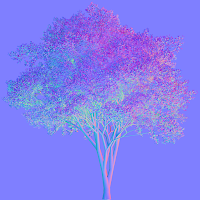Hydra
Hydra component does not generate any geometry on its own, but is able to spawn in a controlled way generation of descendants located in a circle. With almost default parameters the component can produce a structure like this:
Apart of number of descendants and if they are spawned along the whole circle or just in an arc, it is also possible to control their type, probability and orientation with rich set of parameters. Using Hydra component it is possible to describe f.i. petals. If we play with that a bit, we can already create believable blossoms, like this:
This particular blossom we can find among templates coming with Silvador and it can be a good starting point for many types of blossoms.
Urchin
Similar to Hydra, Urchin component also spawns descendants in an organized way. This time the descendants are filling a disc in a hexagonal shape, typical in natural structures. By default Urchin component produces structures like this:
It can be used to describe inner of the blossom - florets (f.i. inner circle of the sunflower). Number of attributes come with Urchin. Apart of density and size of the disc we can also control profile of the disc itself. Note that many attributes including the profile are defined as a curve, addressed by the distance from center.
Examples
All the following examples were created in Silvador with help of the above components. Some of those are present in the gallery distributed with Silvador.





















